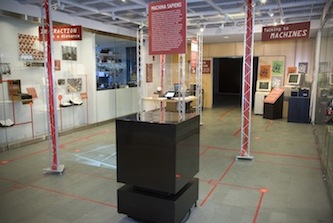Stephanie Dick

Menu:
Go Ask A.L.I.C.E.: Turing Tests, Parlor Games, & Chatterbots
During the 2011-2012 academic year, I was a Wheatland Curatorial Fellow for the Collection of Historical Scientific Instruments at Harvard University. In this capacity, I was one of three curators for the exhibit "Go Ask A.L.I.C.E.: Turing Tests, Parlor Games, & Chatterbots" that ran from September 11, 2012 - December 20, 2012.

"'Can machines think?' This was the question Alan Turing posed in his influential 1950 paper, “Computing Machinery and Intelligence.” Toward answering this question, Turing proposed a parlor game in which an interrogator would converse with two individuals, trying to determine which was the human and which the computer. If the interrogator mistook the computer for the human, that computer could be said to “think”.
This exhibit explores the strange afterlife of the Turing Test as it has circulated in popular, scientific, and commercial cultures. It reexamines elements of Turing’s own interactions with humans and machines, later imaginations of thinking machines, as well as a famous attempt to translate Turing’s parlor game into a real test of artificial intelligence: the Loebner Competition. Visitors to the exhibit will be invited to act as the interrogator in an instantiation of a Turing Test featuring the AI program A.L.I.C.E. Turing’s elegant formulation of the problem of machine thought is here refracted into a complex array of relationships between humans and machines."

Go Ask A.L.I.C.E.
In conjunction with the exhibit, I compiled an original theatrical script - "Go Ask A.L.I.C.E." - consisting of several exploratory vignettes that was performed on the evenings of September 19 and September 20, 2012 by five actors from the American Repertory Theater graduate institute.
Turing's Test for thinking machinery relies on written discourse as the hallmark of intelligence. In the test, a human interlocutor tries to differentiate between a human and a computer by asking them questions. All questions and answers are transmitted on paper, obscuring the materiality and embodiment of human and machine participants. In this theatrical experiment discourse is not rendered textual and routed through teletype machines or computer terminals. Here, human bodies, human voices, human expressions, and face-to- face interactions are the conduits for all communication - human and machine. What meaning does the human form give to language? Why might Turing have stripped that form away in his definition of “thinking”?

